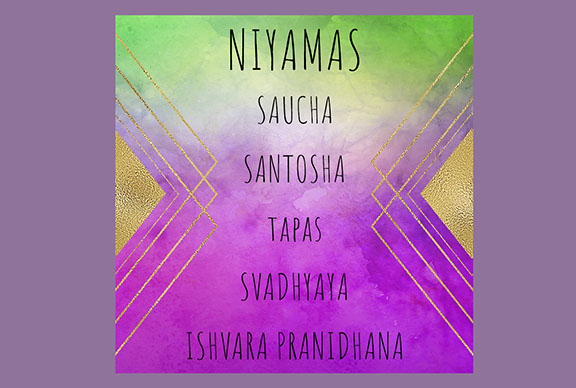
We talked about the general overview of the 8 limbed path (HERE) and covered the first limb last week – the Yamas (HERE). Today we will look at the second limb, the Niyamas, or the guidelines for how to treat yourself according to Patanjali’s Yoga Sutras.
As with the Yamas, there are also 5 guidelines for how to care for yourself, and again, each one is worthy of its own post, but we’ll just cover the abbreviated version here.
- Saucha means cleanliness or purification. Not just in the body, but in the mind and in our speech. It can absolutely include eating properly, getting plenty of rest, and literally taking a shower, however I would invite you to look deeper. Consider all the “impure” thoughts we have that cloud our judgement and perhaps shape our perceptions and even alter how we treat ourselves and others. I think social media can offer a great example of how to practice Saucha. It’s so easy to get caught up in scrolling and getting emotionally invested in a random thread. Then you start reading the snarky comments and may be tempted to reply to them yourself — especially with the anonymity that the world of the internet offers. But in truth, all of this is clouding your mind. It’s taking up space in your brain with potentially harmful thoughts (towards others or yourself). By taking a break from social media completely, or choosing the posts wisely with which we engage, we can BEGIN the practice of Saucha. Trust me, I am completely guilty of the mindless scrolling and I do on occasion get heated over a random post, but I do try to check myself when that happens. I also remind myself regularly that what we see on social media is what others WANT us to see — the perception of reality that they are offering to us — again, a cloudy or even murky version of the truth.
- Santosha, or contentment, is one of my favorites. It can also mean acceptance or optimism. I like to think of this one as perspective — something I’m constantly reminding myself (and my kids) to consider. This one isn’t easy, for me anyway — and certainly not for the kids! Unexpected things happen all the time and derail your plans (*cough* *cough* — COVID!), however if you can find a way to accept what your current reality is and find a way to appreciate the circumstances YOU WILL FEEL BETTER! Revolutionary, I know. We literally cause our own suffering (dukha — my absolute favorite Sanskit word btw — doesn’t it just SOUND like suffering?) by striving to exist and persist in a world that we WANT instead of the world that IS. And this doesn’t apply just to major life altering events. It can be simple. For instance, I am literally trying to write this post and my children are constantly interrupting my thoughts, and I am getting frustrated. Option 1: Stop writing, accept that this work is not going to get done right now, and attend to their needs. Option 2: Leave the space that the kids are in and continue to work without interruption (actively change my reality and circumstances — also a good test to see if they REALLY need me). Either option *should* help to relieve the suffering that I was causing myself. Note: the kids weren’t causing the suffering! My desire to continue working even though the conditions of reality changed caused the conflict in my own mind and led to my frustration. And for those of you who are curious: I chose option two and didn’t hear a peep from the kids. Apparently they did not in fact need anything from me, AND I got to continue writing in peace.
- Tapas literally means heat but in this case can be defined as self-discipline. This can be practiced on the mat, as in literally committing to practice physical postures a certain number of days each week (or every day!). It can also be practiced in any number of ways off the mat. Making a resolution to change certain patterns or behaviors in your life. Sticking to a plan. I would offer a word of caution here for those of you who are also type A (like me) and very driven already. There is a limit to how hard you should push. Finding that limit can be tricky but if you exceed the limit, you can head down an obsessive path which can be harmful. I’m thinking specifically here about things that seem like healthy changes, perhaps regarding diet or exercise, but that when taken to extremes can actually cause more mental anguish if we become too attached to them. We have to balance the strength and rigidity of the self-discipline with some flexibility — bend so you don’t break.
- Svadhyaya, or self-study, is VERY important and I would consider it one of the key ways to achieve liberation and free yourself from suffering. Learning the inner workings of your own mind can be uncomfortable at best, and making changes based on those findings can be even harder. I’m not saying that everything you learn about yourself will be bad (or good — it just IS), but it’s those qualities that we dislike about ourselves that we need to sit with for a moment and consider why we have those tendencies and then maybe question if those tendencies are serving us, or causing us harm. If it’s the latter, then perhaps there is a way to change our ingrained thought patterns and associated behaviors. The first step is simply to RECOGNIZE them. That’s it. Just notice. That’s where self-study begins. You may find this easiest through a consistent physical practice or meditation may be a better way to begin to notice your habitual thoughts and patterns — and a little tapas can help get you there 😉
- Isvara Pranidhana asks us to surrender to a higher power / God / the divine. I’ll admit that this is the one I struggle with the most. I am not a religious person so this is particularly difficult for me to wrap my head around. Perhaps thinking, “it is what it is” may be a good way to apply this Niyama to your life if religion is not your thing either. My husband HATES this expression, but I think it sums up succinctly exactly how to put this into practice. I don’t think it means you should just throw your hands up in the air and let the universe handle all of your problems. However, I think recognizing when things ARE out of your hands allows you the freedom to not worry or stress or concern yourself about all the things that are beyond your control. You can then focus your energy on the aspects of your life that are within your ability to change and use the first 4 Niyamas to help set your mind at ease.
Phew. That was a LOT to unpack — again! I hope you take some time to slow down and consider each of these ideas and how they can be applied to your own life, on or off the mat.
*Caveat / Disclaimer: Please keep in mind I am sharing with you my current understanding of these very complex ideas. I am a middle-aged white woman from the midwest and have only spent the last 6 or 7 years studying this ancient tradition. I implore you to consider these factors, and absolutely seek out other resources to dive deeper for yourself. I also invite you to share YOUR knowledge, in a kind and thoughtful manner, and offer different interpretations of the ideas I have presented as a way for us to all learn and grow.*


